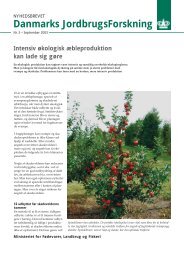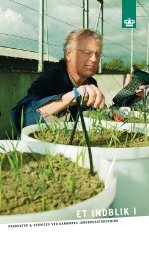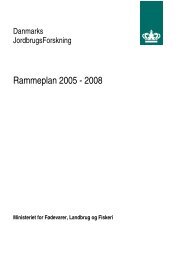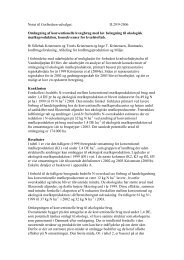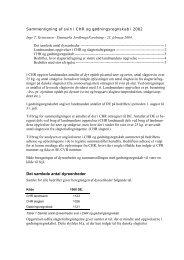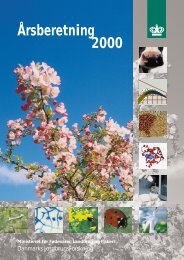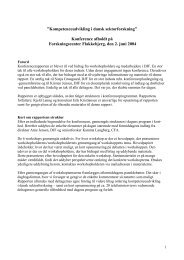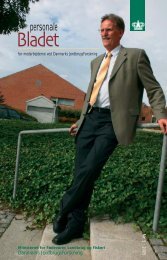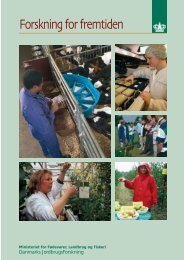Reproduction performances and conditions of group-housed non ...
Reproduction performances and conditions of group-housed non ...
Reproduction performances and conditions of group-housed non ...
Create successful ePaper yourself
Turn your PDF publications into a flip-book with our unique Google optimized e-Paper software.
- Paper III -<br />
Previous work have found that mixing <strong>of</strong> sows into small <strong>group</strong>s (12 <strong>and</strong> 3 sows respec-<br />
tively) lead to the highest level <strong>of</strong> skin injuries (Olsson & Svendsen, 1997) <strong>and</strong> the highest<br />
<strong>and</strong> longest lasting elevated level <strong>of</strong> cortisol (Tsuma et al., 1996) in low ranked sows. In<br />
contrast, Mendl et al. (1992) reported that if sows where mixed into a large <strong>group</strong> (37 gilts),<br />
the intermediate sows received the highest level <strong>of</strong> aggressions <strong>and</strong> had the highest level <strong>of</strong><br />
cortisol. The dominating sows received the lowest level <strong>of</strong> aggressions <strong>and</strong> the submissive<br />
sows were in between. These results indicate that when little free space is available, the<br />
submissive sows are the ones receiving most aggressions probably because they receive<br />
aggressions from both the dominating <strong>and</strong> the intermediate sows, whereas the intermediate<br />
mainly receives aggressions from the dominating sows. In contrast, in large <strong>group</strong>s the<br />
most submissive sows have more chances to avoid the more dominant sows due to more<br />
available free space. Accordingly, this study found that in herds with no escape possibilities<br />
(small <strong>group</strong> sizes <strong>and</strong> no feeding stalls) in the pregnancy unit, first parity (<strong>and</strong> probably<br />
low ranked) sows had significant more lesions compared to older sows three weeks after<br />
mating <strong>and</strong> at farrowing, whereas in herds with escape possibilities, the second-third parity<br />
(<strong>and</strong> probably middle ranked) sows had the highest number <strong>of</strong> skin injuries.<br />
Although not significant, more skin lesions were observed in herds with escape possibilities<br />
in the pregnancy unit, especially at farrowing. One explanation for this could be that the<br />
<strong>group</strong> <strong>of</strong> herds with escape possibilities include the two herds with ESF <strong>and</strong> large dynamic<br />
<strong>group</strong>s with constantly introduction <strong>of</strong> new sows into the <strong>group</strong>. As seen in Figure 1, these<br />
two herds (herd 7 <strong>and</strong> 15) had the highest level <strong>of</strong> lesions at farrowing. This is in agreement<br />
with Leeb et al. (2001) who found significant more lesions in herds with dynamic <strong>group</strong>s<br />
compared to herds with stable <strong>group</strong>s in a field trial that involved 55 herds <strong>and</strong> O'Connell et<br />
al. (2003) who found a higher injury level in dynamic compared to stable <strong>group</strong>s in an<br />
experimental study.<br />
In accordance with Olsson & Svendsen (1995), the frequency <strong>of</strong> lying solitary was highest<br />
on the day <strong>of</strong> weaning. Further, the likelihood <strong>of</strong> lying solitary at weaning was highest for<br />
sows older than third parity, which were also the sows involved in most aggressions at<br />
weaning. Accordingly, Bonde (2004) found that solitary lying behaviour was positive correlated<br />
to involvement in aggressive interactions. Since there was no effect <strong>of</strong> parity <strong>group</strong><br />
on the probability <strong>of</strong> lying at weaning (P=0.8, results not shown) the results was not solely<br />
a consequence <strong>of</strong> old sows lying more <strong>of</strong>ten than younger sows.<br />
Fear tests. According to the results from the human approach test performed at weaning,<br />
first parity sows were more likely to be categorised as fearful compared to older sows. This<br />
trend could however not be rediscovered in the two fear tests three weeks after mating in<br />
the home arena <strong>of</strong> the sows. The test arena for the human approach tests differed inevitable<br />
81




